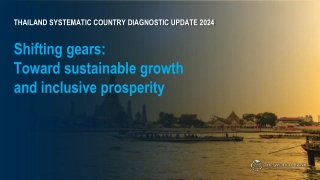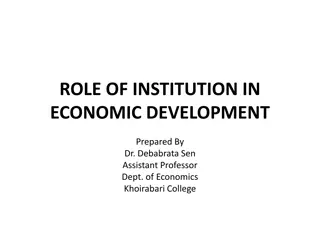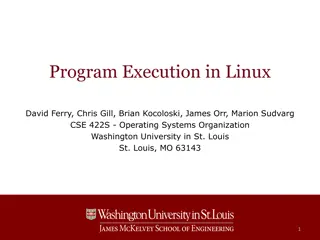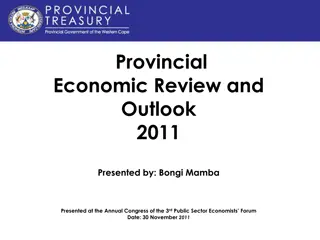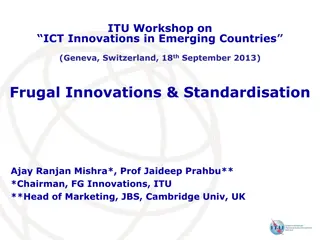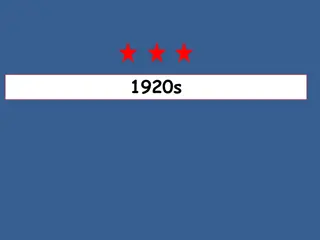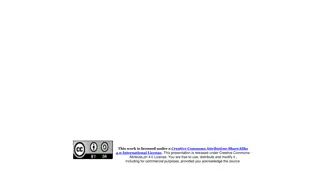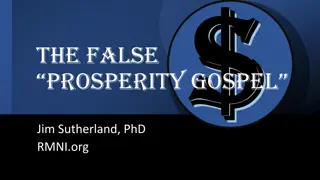Innovation and Economic Growth: Linking Innovation to Prosperity
This content delves into the relationship between innovation and economic growth, exploring models like the Solow-Swan growth model and the concept of technical change. Discover how innovation drives improvements in living standards and welfare, and learn about the impact of knowledge spillovers and R&D on national income.
Download Presentation

Please find below an Image/Link to download the presentation.
The content on the website is provided AS IS for your information and personal use only. It may not be sold, licensed, or shared on other websites without obtaining consent from the author.If you encounter any issues during the download, it is possible that the publisher has removed the file from their server.
You are allowed to download the files provided on this website for personal or commercial use, subject to the condition that they are used lawfully. All files are the property of their respective owners.
The content on the website is provided AS IS for your information and personal use only. It may not be sold, licensed, or shared on other websites without obtaining consent from the author.
E N D
Presentation Transcript
Chapter 9 Innovation and Economic Growth Bronwyn H. Hall & Christian Helmers
Overview Growth models Solow-Swan and technical change Modern growth models with endogenous technical change TFP decomposition and growth accounting Empirical measurement knowledge spillovers social returns to innovation R&D and intangible capital in the national income accounts. 2024 Hall & Helmers Ch. 9 2
Introduction Goal of innovative activity: increase the standard of living and welfare of society. Most of U.S. output growth during the first half of the twentieth century could not be explained by growth of capital and labor inputs alone. Missing output growth conjectured to be the result of technical change/innovation (Solow 1957). What is the link between innovation and economic growth? 2024 Hall & Helmers Ch. 9 3
Solow-Swan growth model Aggregate Cobb-Douglas production function with constant returns to scale. 2 inputs, capital and labor, which combine to produce output: ? = ? ?,? = ????1 ? where A is a scale factor that converts capital and labor into output. Assume profit maximization with respect to ? and ? given the relative real wage ? and the real return to capital ?. First order conditions: max ?,?? ?,? ?? ?? ? =?? ??= 1 ? ? =?? ? ? ??= ?? ? At optimum, ?is equal to capital s share ??/? and (1 ?)is equal to labor s share ??/?. 2024 Hall & Helmers Ch. 9 4
Solow-Swan growth model ? and (1 ?) correspond to elasticities of output with respect to capital and labor: ? =? ?? ?? ? 1 ? =? ?? ?? ? Zero profits, since capital and labor account for all revenue: ? = ?? + ?? = 1 ? ? + ?? 2024 Hall & Helmers Ch. 9 5
Solow-Swan model with labor augmenting technical change Assumptions: Constant savings rate over time s; Constant depreciation rate ? of capital K; Constant population and labor growth n; Closed economy (no trade or investment in or out the country). Net investment (the change in capital stock): ?? ?? ? = ?? ?? Redefine labor to incorporate A, assume growth in productive efficiency over time is growth in effectiveness of labor: ? = ?1 ? ? = ??( ??)1 ? 2024 Hall & Helmers Ch. 9 6
Solow-Swan model with labor augmenting technical change Assume exogenous growth ? in ? (technical efficiency). ?? has growth rate ? + ?. Define ? as effective capital-labor ratio ?/??. Equilibrium growth in capital: ? ?= ? ? ? ? = ?? ? ?=?? ?? ? ? ? ? ? ? ? ? = ?? ? + ? + ? ? Equilibrium growth in output (? = ?/??, the effective output-labor ratio): ? ?=1 ??? ? (? + ? + ?) 2024 Hall & Helmers Ch. 9 7
Solow-Swan growth model with labor-augmenting technical change 2 conclusions from this simple model: 1. Growth in capital-labor ratio depends positively on the savings rate and negatively on depreciation, labor growth, and the current capital-labor ratio. 2. Growth in output depends positively on the savings rate and the output-capital ratio and negatively on depreciation, and labor growth. Other things equal, growth is lower when capital share is higher. 2024 Hall & Helmers Ch. 9 8
Solow-Swan growth model with labor-augmenting technical change Because ? = ??, steady state derived from rate of change of capital-effective labor ratio: ? = ?? ? + ? + ? ? = ??? ? + ? + ? ? Setting rate of change of effective capital-labor ratio to zero, we get equilibrium value of capital and output per worker: 1 ? (1 ?) ? = ? + ? + ? ? ? (1 ?) ? = ? + ? + ? Central prediction of the Solow-Swan growth model: equilibrium capital-labor ratio and labor productivity are higher when the savings rate is higher and lower when depreciation and labor growth are higher. Model predicts diminishing returns to both capital and labor inputs and that output growth depends only on exogenous population growth n and exogenous technical change g. 2024 Hall & Helmers Ch. 9 9
Empirical growth accounting Solow-Swan model provides framework for growth analysis and to identify empirical puzzles via deviations from its predictions. Use growth accounting approach to estimate technical change A. Aggregate production function indexed by time t: ? ? = ? ? ?[? ? ,?(?)] Y(t) is aggregate output (GDP) in year t. Labor L(t) is measured in person-hours or number of workers. 2024 Hall & Helmers Ch. 9 10
Empirical growth accounting Differentiate output Y(t) with respect to time t: ?? ??=?? ?? ??=?? ?? + ?(?)??[? ? ,? ? ] ??? ? ? ,? ? ?(?) ?(?)+ ?[?,?] ?? ?(?) ??(?,?) ?? ?? ??+??(?,?) ?? ?? ?? Divide by Y(t) and multiply second term by K/K and third term by L/L: 1 ? ?? ?(?,?) ?? ?? ??=?? 1 ?(?) ??(?,?) 1 ?? ??+ ?(?) ?(?,?) ??(?,?) ?? 1 ?? ?? ?(?)+ ?(?) ?(?) 2024 Hall & Helmers Ch. 9 11
Empirical growth accounting Substituting growth rates g for 1 ?? ??: ? ?(?) ?(?,?) ??(?,?) ?? ?(?) ?(?,?) ??(?,?) ?? ??= ??+ ??+ ?? Rewrite to express output growth as (approximate) sum of productivity growth (technical change) and the growth of inputs, weighted by their elasticities in the production function: ??= ??+ ????+ ???? where ?? and ??denotes elasticity. 2024 Hall & Helmers Ch. 9 12
Empirical growth accounting Solow (1957) using Cobb-Douglas production function and constant returns to scale: ??= ?? ?? Using data averaged over the 1909-1949 time period: ??= 2.72% - 0.34 1.53% - 0.66 1.00% = 2.72% - 0.52% - 0.66% = 1.54% More than half of output growth (2.72%) not explained by growth in capital and labor inputs (1.18%). ??called Solow residual or total factor productivity growth . Measure of our ignorance (Abramovitz, 1956). ???+?? ??? 2024 Hall & Helmers Ch. 9 13
Solows estimated A for the U.S. non-farm economy 2024 Hall & Helmers Ch. 9 14
Modern growth theory Incorporate idea that A is not an unknown exogenous productivity level, but generated by changes in knowledge and human capital in the economy: Jones (1995) MRW (1992) P. Romer (1990) Aghion and Howitt (1992) Grossman and Helpman (1991, 1994) 2024 Hall & Helmers Ch. 9 15
AK models (Jones, 1995) Motivated by observation that levels of human capital vary considerably across countries and are result of investments made prior to use. In AK model labor input is human capital subject to improvement over time. Aggregate production function: ??= ??????1 ? Capital K and human capital H evolve as follows: ??= ????? ??? ??= ?? ?? ??? where ??denotes gross investment rates in capital and human capital. 2024 Hall & Helmers Ch. 9 16
AK models (Jones, 1995) Model closed with equation for intertemporal consumption preferences. Capital and human capital will accumulate at the same rate. Equilibrium ratio of capital and human capital: ? =? ?=(1 ?) ? Production function can be written as a function of capital only, which is why this class of models is called AK: ??= ??? with ? = ??1 ? Steady state growth rate of output: ??= ? + ??? AK model poor representation of growth process. Growth rates in most OECD economies since 1950 fluctuate without a general increasing tendency, while investment rates in several countries grew. Model predicts constant returns to capital accumulation rather than diminishing returns. 2024 Hall & Helmers Ch. 9 17
MRW (1992) Mankiw, Romer, and Weil (1992) incorporate human capital by adding a separate human capital term. Assume capital and human capital evolve as a function of investment with constant gross investment rates. ??= ????? ??= ???? ? + ? + ? ?? ?= ? ?? (? + ? + ?) ? where capitals and output are normalized by effective labor: ? = ?/??, ? = ?/??, and = ?/??. ?(????)1 ? ? 2024 Hall & Helmers Ch. 9 18
MRW (1992) Model contains exogenous evolution of productivity (growth g in A) and endogenous growth in knowledge and skills that is spread across the economy. Model yields empirical expression for labor productivity: ?? ?? ) + ? + 1 ? ?log??+ Functions of ? and ? will be treated as unknown parameters to be estimated. ? + ? 1 ? ?log( ? 1 ? ?log? log = log?0+ ?? ? ? + ? 2024 Hall & Helmers Ch. 9 19
MRW (1992) MRW proxy capital investment rate ?? by investment-GDP ratio and human capital investment rate ? by share of population in secondary school. n is rate of growth of working age population. ? + ? is set to 0.05. Estimates show that omission of human capital in the original model did bias coefficients upwards, and that adding (poorly measured) proxy corrects bias and yields reasonable results. Estimated capital and human capital shares (? and ?) are both around 0.3, leaving 0.4 for labor. Constant returns in all three inputs is accepted, which implies diminishing returns in the two capitals. 2024 Hall & Helmers Ch. 9 20
Endogenous growth models Models capture idea that conscious activities of firms generate growth via their investments in innovation. Knowledge relevant for innovation is both nonrival and partially excludable: Firms will need some rents or profits to pay the cost of innovation, leading to imperfect rather than perfect competition. At aggregate level, the social returns to innovative activity by firms may exhibit increasing returns, even if each firm faces diminishing returns. Increasing returns characteristic is central difference from traditional growth models such as Solow-Swan. 2024 Hall & Helmers Ch. 9 21
Endogenous growth models Innovation is performed in different ways in the three models but with generally same impact on aggregate growth: P. Romer: individuals produce new designs, sell to intermediate goods firms who produce using them, these firms sell above marginal cost, and their quasi-rents cover the cost of purchasing the designs. There is entry until profits are zero. Aghion-Howitt: sequence of innovations, each of which improves on previous (a quality ladder), and whose provision is determined by comparing the cost of raising the expected probability of an improvement to the wage. Each innovation will earn rents until it is displaced by an improved product, which is a way of incorporating creative destruction. Grossman-Helpman: versions of both of the above, calling them variety expansion and quality expansion, and showing that results are similar, although welfare implications are different. 2024 Hall & Helmers Ch. 9 22
Endogenous growth models (Jones, 1995) Total labor ? = ??+ ?? ??: labor used in production ??: labor used in knowledge production Labor grows exogenously at rate n. Key feature equation for knowledge accumulation: ? = ????? ? introduces research spillovers into the model. Assume that ? < 1, balanced growth path where knowledge, output per worker, capital services per worker, and the capital-labor ratio grow at rate g: ? with 0 < ? 1 ?? ? = 1 ? Note: decentralized economy will tend to underinvest in R&D relative to social optimum, given the presence of spillovers. 2024 Hall & Helmers Ch. 9 23
Explaining the growth in total factor productivity (TFP) Solow s finding that most of U.S. output growth during the first half of the twentieth century was not explained by growth in capital and labor motivated empirical work to explain this result by Improving measures of capital and labor to incorporate quality change. Including measures of disembodied knowledge capital. 2024 Hall & Helmers Ch. 9 24
Sources of growth (Jorgenson and Griliches, 1969) How to measure both real output and real input using the data commonly available from national income accounts. Consider many outputs and many inputs and start with the accounting identity implicit in national income accounts. ?1?1+ ?2?2+ ?3?3+ = ?1?1+ ?2?2+ ?3?3+ or ?=1 ????= ?=1 where ?? is the quantity of the ith output and ??as the quantity of the jth input. ?? and ??are the corresponding prices. ? ? ???? 2024 Hall & Helmers Ch. 9 25
Sources of growth (Jorgenson and Griliches, 1969) Total factor productivity is obtained by differentiating identity with respect to time and dividing each side by the total values: ? ?? ?=1 ?=1 ?=1 ? ?? ?? ?=1 Where ??is the relative share of the ith output in total output: ??= ? ? ? ? ????+ ?? ?? ???? ???? ???? ???? ???? ?? ?? ???? ???? ???? ????= ????+ ?? ?? = = + ?=1 ? ?? ?? = ?? + ?? ?=1 ???? ???? Total output growth is the sum of two indices, one for price and one for quantity: ? ?= ?=1 ?? ?? and ? ?= ?=1 ?? ?? ? ? ?? ?? 2024 Hall & Helmers Ch. 9 26
Sources of growth (Jorgenson and Griliches, 1969) Defining productivity as ratio of real output to real input, productivity growth is defined by the usual time derivative of this quantity: ? ?= Let s simplify the problem so it looks like the growth accounting that Solow did: ? ? ?? where ? (real output) measured as real private gross domestic product from the national income accounts and ? and ? are both real quantity measures. ? ? ? ? ??? = ? ? ?? ? ? ??? = ? ? 2024 Hall & Helmers Ch. 9 27
Sources of growth (Jorgenson and Griliches, 1969) 2 main measurement challenges: 1. Appropriate concept for capital in the production function is capital services . 2. Proper measure of utilization of both capital and labor. Jorgenson and Griliches (1967, 1972) showed that measuring labor, capital, and output more carefully reduced the unexplained residual TFP from 1.96% to 1.03%. 2024 Hall & Helmers Ch. 9 28
Sources of growth (Jorgenson and Griliches, 1969) Appropriate concept for capital in the production function is capital services : capital times its rental price for the period, with adjustments for depreciation and utilization. Suppose there are ? number of capital inputs ? indexed by ?. Each type of capital created by investment ?? and depreciates at rate ??. Quantity ?? and price ?? of each capital: ??+1 = 1 ?????+ ??? ? ? ?? ?? ?= ?? ? ?? ? + ?? ? where r is the interest rate (required net rate of return to capital) 2024 Hall & Helmers Ch. 9 29
Sources of growth (Jorgenson and Griliches, 1969) To create the capital aggregate, individual capitals are aggregated using Divisia index formula: ?? ?? where weights are share of implicit rental value for each capital ???? ? ??? ?? = ?? ? ?=1 ??. For labor input, a similar procedure needs to be followed (prices are directly measured via wages for different types of labor.) 2024 Hall & Helmers Ch. 9 30
Sources of growth (Jorgenson and Griliches, 1969) Another challenge in measuring the inputs to productivity: proper measure of utilization of both capital and labor. Idle machines or reserve employees do not contribute directly to current output, but may still be productive in the sense that they reduce future adjustment or hiring costs. One possible solution is to use indices of power usage over time to proxy for utilization of capital. For labor, it is common to obtain actual person-hours in lieu of number of employed persons. 2024 Hall & Helmers Ch. 9 31
Contributions to the growth of labor productivity in the U.S. nonfarm business sector 2024 Hall & Helmers Ch. 9 32
TFP and R&D investment Given the unexplained residual identified with technical change in the Solow growth model, include stock of R&D as input in production function to help explain the residual: ? = ??(?,?,?) ? is a measure of the knowledge stock and ? is residual productivity change not captured by investments in R&D. Given the augmented production function: ?? ??=marginal product of ? (gross rate of return) ? This leads to a revised growth accounting equation: ??= ??+ ????+ ????+ ???? Griliches (1980) used U.S. data from 1957 to 1965 to find an R&D elasticity of about 0.07, and private R&D growth of around 15% per year, which implies contribution to growth was 1%. Many others have repeated this analysis for different countries and time periods. ? ?? ??= ??=elasticity of output with respect to ? 2024 Hall & Helmers Ch. 9 33
R&D and innovation spillovers Implication of endogenous theory: disembodied unpriced knowledge creation has an important role in generating output growth. Knowledge is non-rival and only partially excludable. Some of new knowledge and benefits from R&D not appropriated by innovator. Many reasons: Imperfect patent protection Inability to keep innovations completely secret Imitation via reverse engineering Knowledge spillovers: unpriced knowledge transfers to entities other than innovator. Spillovers explain gap between social and private returns to innovation. Spillovers come from other firms in the industry, firms in other industries, public research institutes and laboratories, domestic and abroad. 2024 Hall & Helmers Ch. 9 34
Case studies: computation of the private and social rates of return to innovation 2024 Hall & Helmers Ch. 9 35
Econometric spillover studies Basic framework is production function modified by adding term ? that measures contribution of external R&D or innovation to own productivity: ? = ??(?,?,?,?) ? constructed as weighted average of R&D by those external to the firm (or industry or country), with weights proportional to some measure of closeness of external actor. Let ? index the firm, industry, or country, and ? index other firms, industries, or countries that might spill knowledge to ?: ???= ?????? ? ? where the ??? are weights that describe closeness of ? to ?. 2024 Hall & Helmers Ch. 9 36
Econometric spillover studies Can think of closeness ???as mechanisms for transmission of spillovers. Many ways to measure closeness ??? Across firms: Closeness in technological space as measured by patent profiles R&D intensity of intermediate input and capital purchases Informal and more formal communication (attendance at workshops and trade fairs, collaborations) Patent flows between industries Imports Worker mobility among firms Various measures of technological and product market closeness Also within firms (e.g. across research groups). Horizontal (between competitors) vs vertical (supplier and user) . Also spillovers from government and university R&D to private companies and vice versa. 2024 Hall & Helmers Ch. 9 37
Geographic spillovers Important concentrations of innovation at various times and places: Silicon Valley for digital hardware and software today. Detroit, Michigan for automobiles in the first half of the twentieth century. Fashion industry in Paris, and then London and Milan. Concentration due to localized knowledge spillovers from chance encounters and employee mobility, reflecting the importance of tacit knowledge in furthering innovative activities. Patent data show that citations from one patent to another are more probable if the patents were co-located (Jaffe et al. 1993). 2024 Hall & Helmers Ch. 9 38
Social returns (Jones and Summers, 2022) Can we compute social returns to R&D? Ratio of social benefits ? to social cost ? of R&D is given by the following: ? ?=? where ? is economy wide discount rate and ? growth rate. Social return to R&D is rate ? that makes benefits equal to costs (?/? = 1): ? = ?? Back of the envelope computation using recent U.S. data with R&D intensity ?/? = 2.7% and ? = 1.8% implies an average social rate of return to R&D of 67%. ? ? ? ? 2024 Hall & Helmers Ch. 9 39
R&D in the national income accounts Fuller understanding of the investment nature of R&D and its increasing importance in investment spending led government statisticians to include spending on R&D and other intangibles in National Income and Product Accounts as investment. Change to treating it as capital investment increases GDP and also increase the services from capital. In U.S., in 1959, including R&D investment increased measured GDP by 1.5% whereas in 2012 the increase was 2.4% (Moylan and Okubo, 2020). In U.S., R&D satellite account developed in 1994 and R&D was incorporated into main National Income and Product Accounts (NIPA) in 2013. In EU, ESA2010 specified that R&D should be included in satellite account and moved to core account as measurement improved and harmonized across member states. 2024 Hall & Helmers Ch. 9 40
Summary Economic growth cannot be explained by capital and labor. Unexplained growth ( residual ) associated with innovation and technological change in production. Models that endogenize innovation can explain economic growth. Importance of innovation justifies policy focus on innovation and R&D. Growth models highlight crucial role of spillovers in driving economic growth. 2024 Hall & Helmers Ch. 9 41
Summary R&D and innovation spillovers: unpriced product of R&D investment that benefits other firms, individuals, and countries. Spillovers are substantial and (at least high income) countries are underinvesting in R&D. Many ways to measure knowledge spillovers: macro modeling, empirical macro estimation, production function estimation, and microeconomic studies. Empirical finding: social rates of return to R&D that are 2 to 4 times the private rate of return. Belief in the importance and value of knowledge base to an economy has led countries to develop their systems of national accounts to include measures of R&D capital and other intangible assets, treating these as investments rather than expenditures, by analogy to ordinary fixed capital investment. 2024 Hall & Helmers Ch. 9 42
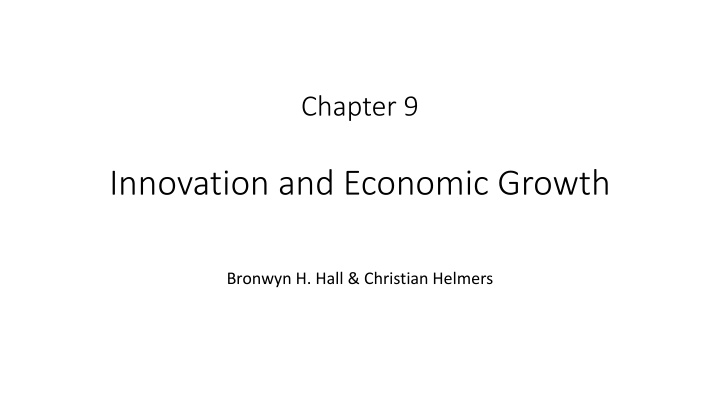

![Read⚡ebook✔[PDF] Linking the Space Shuttle and Space Stations: Early Docking Te](/thumb/21519/read-ebook-pdf-linking-the-space-shuttle-and-space-stations-early-docking-te.jpg)
